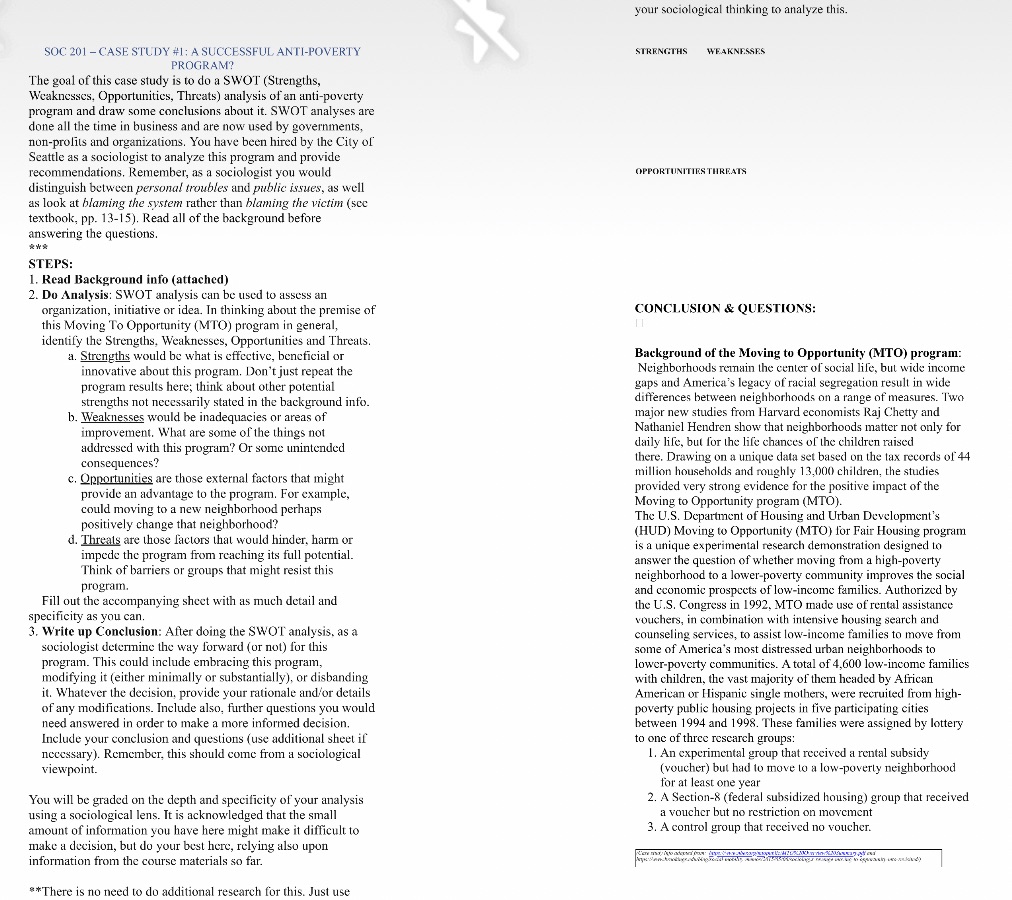Answered step by step
Verified Expert Solution
Question
1 Approved Answer
SOC 201 CASE STUDY #1: A SUCCESSFUL ANTI-POVERTY PROGRAM? The goal of this case study is to do a SWOT (Strengths, Weaknesses, Opportunities, Threats)

SOC 201 CASE STUDY #1: A SUCCESSFUL ANTI-POVERTY PROGRAM? The goal of this case study is to do a SWOT (Strengths, Weaknesses, Opportunities, Threats) analysis of an anti-poverty program and draw some conclusions about it. SWOT analyses are done all the time in business and are now used by governments, non-profits and organizations. You have been hired by the City of Seattle as a sociologist to analyze this program and provide recommendations. Remember, as a sociologist you would distinguish between personal troubles and public issues, as well as look at blaming the system rather than blaming the victim (sec textbook, pp. 13-15). Read all of the background before answering the questions. *** STEPS: 1. Read Background info (attached) 2. Do Analysis: SWOT analysis can be used to assess an organization, initiative or idea. In thinking about the premise of this Moving To Opportunity (MTO) program in general, Ing identify the Strengths, Weaknesses, Opportunities and Threats. a. Strengths would be what is effective, beneficial or innovative about this program. Don't just repeat the program results here; think about other potential strengths not necessarily stated in the background info. Weaknesses would be inadequacies or areas of improvement. What are some of the things not addressed with this program? Or some unintended consequences? c. Opportunities are those external factors that might provide an advantage to the program. For example, could moving to a new neighborhood perhaps positively change that neighborhood? d. Threats are those factors that would hinder, harm or impede the program from reaching its full potential. Think of barriers or groups that might resist this program. Fill out the accompanying sheet with as much detail and specificity as you can. 3. Write up Conclusion: After doing the SWOT analysis, as a sociologist determine the way forward (or not) for this program. This could include embracing this program, modifying it (either minimally or substantially), or disbanding it. Whatever the decision, provide your rationale and/or details of any modifications. Include also, further questions you would need answered in order to make a more informed decision. Include your conclusion and questions (use additional sheet if necessary). Remember, this should come from a sociological viewpoint. You will be graded on the depth and specificity of your analysis using a sociological lens. It is acknowledged that the small amount of information you have here might make it difficult to make a decision, but do your best here, relying also upon information from the course materials: far. **There is no need to do additional research for this. Just use your sociological thinking to analyze this. STRENGTHS WEAKNESSES OPPORTUNITIES THREATS CONCLUSION & QUESTIONS: Background of the Moving to Opportunity (MTO) program: Neighborhoods remain the center of social life, but wide income gaps and America's legacy of racial segregation result in wide differences between neighborhoods on a range of measures. Two major new studies from Harvard economists Raj Chetty and Nathaniel Hendren show that neighborhoods matter not only for daily life, but for the life chances of the children raised there. Drawing on a unique data set based the tax records of 44 million households and roughly 13,000 children, the studies. provided very strong evidence for the positive impact of the Moving to Opportunity program (MTO). The U.S. Department of Housing and Urban Development's (HUD) Moving to Opportunity (MTO) for Fair Housing program is a unique experimental research demonstration designed to answer the question of whether moving from a high-poverty neighborhood to a lower-poverty community improves the social and economic prospects of low-income familics. Authorized by the U.S. Congress in 1992, MTO made use of rental assistance vouchers, in combination with intensive housing search and counseling services, to assist low-income families to move from some of America's most distressed urban neighborhoods to lower-poverty communitics. A total of 4,600 low-income families with children, the vast majority of them headed by African American or Hispanic single mothers, were recruited from high- poverty public housing projects. five participating cities between 1994 and 1998. These families were assigned by lottery to one of three research groups: 1. An experimental group that received a rental subsidy (voucher) but had to move to a low-poverty neighborhood for at least one year 2. A Section-8 (federal subsidized housing) group that received a voucher but no restriction on movement 3. A control group that received no voucher.
Step by Step Solution
There are 3 Steps involved in it
Step: 1
SWOT Analysis Moving to Opportunity MTO Program Strengths 1 Positive Impact The Harvard studies indi...
Get Instant Access to Expert-Tailored Solutions
See step-by-step solutions with expert insights and AI powered tools for academic success
Step: 2

Step: 3

Ace Your Homework with AI
Get the answers you need in no time with our AI-driven, step-by-step assistance
Get Started


